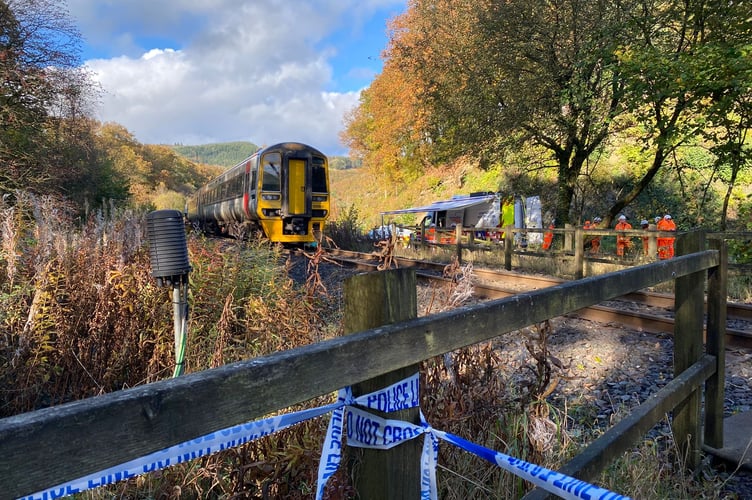RAIL investigators have released an interim report into what caused two trains to collide on the Cambrian Line near Talerddig in October last year.
The collision resulted in the death of 66-year-old Tudor Evans from Capel Dewi, Aberystwyth and left four other people seriously injured, with 11 others requiring hospital treatment.
The report says a total of 37 people were on the two trains at the time of the collision.
On Wednesday, 30 April, The Rail Accident Investigation Branch (RAIB) has published its interim report into the collision between passenger trains near Talerddig, Powys, 21 October 2024.
Investigators say that they have found four defects with a sanding system, which deploys sand to to improve friction between wheels and track.
At around 7.26pm on Monday 21 October 2024, train reporting number 1J25, the 18:31 passenger service from Shrewsbury to Aberystwyth, collided with train reporting number 1S71, the 19:09 Machynlleth to Shrewsbury passenger service.
Both services were operated by Transport for Wales Rail Limited (TfWRL).
The collision took place on to the west of the passing loop located at Talerddig, Powys.
One passenger died and four other people were seriously injured.
The report said: “There were 31 people on board train 1J25, including the train driver, the guard and one other member of TfWRL staff.
.png?width=752&height=500&crop=752:500)
"One person died and three people were seriously injured.
"The person who died and all the people with serious injuries were travelling in the rear carriage of train 1J25.
"This included the train’s guard, who was standing up at the time of the accident.
"RAIB has been able to confirm that a further 18 people received minor injuries.
"The remaining passengers have either reported suffering no injuries or RAIB has not been able to obtain information from them about any possible injuries.
"There were six people on board train 1S71, including the train driver and the guard.
"The driver was in the process of attempting to leave the driving cab when the collision occurred.
"The driver became trapped during the collision and was seriously injuried.
"The remaining five people on board reported minor injuries.
"The driver of train 1S71 was trapped in the driving cab and needed assistance from the driver of train 1J25 and a passenger to force open the damaged door from the cab into the passenger area. All other passengers had a viable means of escape."
Neither train derailed in the collision, although significant damage was caused to the leading vehicles of both trains.

From each direction, the railway approaching Talerddig passing loop consists of a single line, with the loop allowing trains to pass each other. Train 1J25, travelling west, was due to stop in the loop to allow eastbound train 1S71 to pass it. Train 1J25 was braking as it approached and passed through the loop. Despite this it was unable to stop within the loop as intended.
The train subsequently exited the loop, while still braking, and re-entered the single line, heading towards train 1S71. Train 1J25 travelled approximately 1,080 metres beyond its intended stopping point, before colliding with train 1S71.
At the time of the collision, train 1J25 was travelling at approximately 39 km/h (24 mph), while train 1S71 was travelling in the opposite direction at approximately 11 km/h (6 mph).
The report said: “The application of sand is a well-established mitigation for low wheel-rail adhesion conditions and can help restore braking performance.
“When needed, sand is dispensed from the train and delivered through hoses aimed directly at the wheel-rail interface.
"Most passenger trains which operate on GB mainline railways are fitted with an on-board sanding system.
“Both trains involved at Talerddig were equipped with on-board sanders.
“Following the accident, RAIB inspected and tested the automatic sanding system on vehicle 57841. Four defects were identified:
“1 - The sander isolation switch, which provides electrical power to the automatic sanding system, was not allowing current to pass. The switch was found to be physically in the correct position (labelled as ‘Normal’), but when tested electrically it was found to be open circuit. If present at the time of the accident, this fault would have prevented the automatic sander from operating.
“2 - The low-speed relay is a device which inhibits automatic sanding below a threshold speed of 10 km/h (6 mph).
“This is intended to prevent discharge of sand at low speed, since it could interfere with the railway signalling system.
“The relay was found to be defective when tested. If present at the time of the accident, this fault would also have prevented the automatic sander from operating.
“3 - The orifice plates, which are part of the sander pneumatic system, were found to be installed incorrectly (both were upside down and one was incorrectly aligned). This fault could lead to a reduced sand delivery rate from the automatic sanders.
“4 - Both sand delivery hoses were found to be blocked.
“This fault would have prevented sand from being ejected from the hoses.
“No defects relating to the sanders were reported by any drivers of unit 158841 on 20 or 21 October.
“However, it cannot be determined if the train encountered areas of low wheel-rail adhesion during this period which would have activated these systems and potentially alerted drivers to any defects which may have existed.

“The blocked sand delivery hoses were identified shortly after the accident while the trains were still on site at Talerddig.
“The two electrical defects and the incorrectly installed orifice plates were observed by RAIB during subsequent testing in January 2025 (11 weeks after the accident). These electrical faults may have been present at the time of the accident, may have been introduced as a consequence of it, or may have arisen during post-accident recovery and storage.
“After the accident, RAIB removed the blocked sand hoses for analysis. Although the hoses were blocked at the outlet end, there was no evidence of any significant build-up of sand in the pipe behind the blockage.
“There was dry sand in the sand hopper, and sand flowed freely from the sand valve under the hopper when the test button was pressed during subsequent testing.
“A detailed examination of one of the blocked hoses has been undertaken.
“The blockage consisted of a plug of material which was approximately 30 mm deep in the outlet end of the sand hose. RAIB considers that the material blocking the hose probably originates from a source external to the sanding system.
“Visual examination of the material with an optical microscope revealed organic matter and very small particles of sand-like material.
“Preliminary DNA testing of the organic material indicates that it comprises leaves and debris originating from ash, acer and wild cherry trees.”
The report added that early on the morning of 21 October, a train driver prepared the train for service.
However, the train was positioned adjacent to a platform.
This meant that the driver did not have access to equipment on the train’s underframe, including the sander test button.
Consequently, certain safety systems, including the operation of the automatic sanding system, could not be checked.
The 158 Class trains operating on the Cambrian Line and involved in the collision were built between 1989 and 1992.
As was common with trains built at that time, no sanding systems were originally fitted.
However, due to problems with the trains’ performance in low wheel-rail adhesion conditions, a need was recognised to fit sanding systems. The emergency one-shot sanding system was therefore developed and fitted to class 158 trains in the late 1990s.
Since the collision, the industry has taken action with a paper released entitled ‘Class 158 sander hidden fault’ which highlights electrical defects identified with the automatic sanding system.
The investigation will continue with RAIB setting out its next objectives, which are: “Continue to develop an understanding of the sequence of events.
“Continue to establish, as far as practical, the cause and severity of low wheel- rail adhesion at Talerddig.
“Complete the testing of the braking, wheel slide protection and sanding systems on train 1J25.
“Consider the actions of the drivers of both trains and any factors which may have influenced them.
“Consider the actions of the signaller and any factors which may have influenced them.
“Consider the actions taken on the day of the accident to manage the risk of low wheel-rail adhesion given the time of year and prevailing weather conditions.

“Consider Network Rail’s policies and processes relating to low adhesion and how it managed the risk, including vegetation management, the role of TGAs and how they are maintained, and railhead cleaning.
“Consider TfWRL’s policies and processes relating to operating trains in low adhesion.
“Consider how the Cambrian ERTMS system was designed and implemented, including how operation in low adhesion was intended to be managed.
“Consider the behaviour of both trains during and following the collision, and the damage caused to each.
“Consider any factors which may have affected the severity of the consequences, including the actions of emergency services.
“Identify any relevant underlying factors, including any actions taken in response to previous safety recommendations and research conducted in relation to managing the risks of low adhesion.
“Make recommendations, as appropriate, to prevent a recurrence.”
A final report will be published by RAIB on completion of its investigation.
An inquest into David Tudor Evans, 66, was opened and adjourned in October last year.
During the hearing, Assistant coroner for Ceredigion Louisa Corcoran said that Mr Evans, known as Tudor, was identified at the scene by his wife, Rachel Evans.
He had been travelling home from a holiday in Italy.
At the inquest, Ms Corcoran said a post-mortem examination was in progress, and therefore no medical cause of death had yet been recorded.
She also said no pre-inquest date had been set "due to the complexity" of the investigation but that a date would be confirmed in due course.
Mr Evans’ family thanked people for their kind messages and support and asked for privacy.
Following the collision, Nick Millington, Network Rail’s Wales & Borders route director said: “Monday night’s tragic events will forever be etched in my memory and my thoughts remain with all those affected. Thankfully, incidents like this are extremely rare on the railway network. We continue to operate one of the safest railway networks in Europe.
“Our engineers have been on site throughout and have conducted very thorough safety checks and we will run test trains through the area.
“I am grateful to the local community who have been very accommodating throughout this last week while we have been managing this incident.”
Jan Chaudhry van der Velde, chief operating officer for TfW, said: “The railways in Wales have a very good safety record, so when serious incidents like this happen, we at TfW, together with our partners at Network Rail, are determined to get to the bottom of what caused it. For that reason, we are co-operating fully with the authorities investigating the collision, and in particular, the Rail Accident Investigation Branch.
“Our condolences go to the family of the passenger who passed away, and we hope that those passengers and staff members injured in the collision make a speedy recovery.”
Transport for Wales is currently introducing new trains on its network, with Class 197 trains introduced to the Cambrian Line service between Birmingham and Shrewsbury ‘earlier than planned’, but the line to Aberystwyth and Pwllheli will have to wait until the end of the year.
This is due to the Cambrian Line between Shrewsbury and Aberystwyth an up to Pwllheli using a digital signalling and train control systems known as European rail traffic management system (ERTMS) and European train control system (ETCS).
A spokesperson for Transport for Wales said earlier this year: "As part of our £800m investment in brand new trains, we'll be introducing Class 197 trains, made in Newport in South Wales, onto the Cambrian Line.
"We are actively looking to introduce new trains earlier than planned between Shrewsbury and Birmingham.
"Because the Cambrian line uses a specialist signalling system, further operational work is required to introduce the trains between Pwllheli/Aberystwyth/Shrewsbury but we expect to complete this towards the end of 2025.”
When asked whether passengers using the Welsh section of the line would have to change trains in Shrewsbury, the spokesperson added: “It will mean some services will require a change at Shrewsbury, details of that are being finalised and info will be released in due course. “




Comments
This article has no comments yet. Be the first to leave a comment.